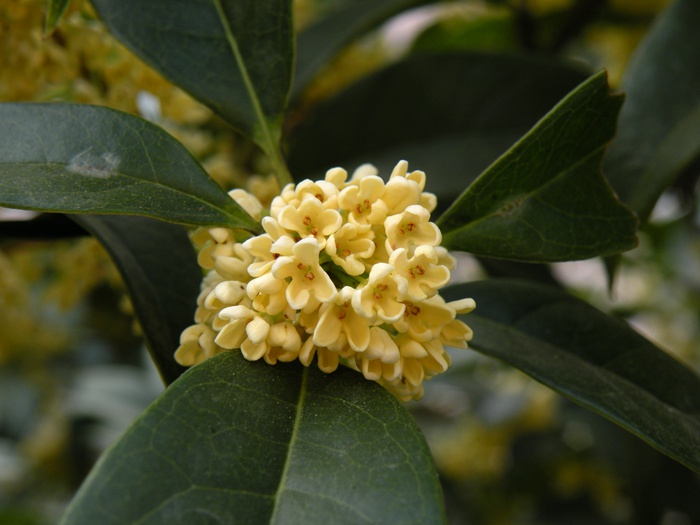- Scientific Name: Osmanthus fragrans Lour.
- Ref: Fl. Cochinch.:29. 1790
- Synonyms:
- Notelaea posua D.Don
- Olea acuminata Wall. ex G.Don
- O. buchananii Lamb. ex D.Don
- O. ovalis Miq.
- O. posua Buch.-Ham. ex D.Don
- Osmanthus asiaticus Nakai
- O. intermedius Nakai
- O. latifolius (Makino) Koidz.
- O. macrocarpus P.Y.Pai
- English Common Name: fragrant olive, tea olive, sweet olive, sweet osmanthus
- Chinese Common Name: 木犀 mùxī, 桂花 guìhuā
- Japanese Common Name: モクセイ [木犀] mokusei, ギンモクセイ [銀木犀] ginmokusei
- Family: Oleaceae
- Genus: Osmanthus
- Distribution: Guizhou, Sichuan, Yunnan. Widely cultivated for the perfume of flowers. Varieties based on flower color are only cultivars.
Trees or shrubs 3-5(-10) m, glabrous. Petiole 0.8-1.2 (-1.5) cm; leaf blade elliptic to elliptic-lanceolate, 7-14.5 × 2.6-4.5 cm, base cuneate or broadly cuneate, margin entire or usually serrulate along distal half, apex acuminate; midrib and 6-8(-10) primary veins adaxially impressed and abaxially raised. Cymes fascicled in leaf axils, many flowered; bracts broadly ovate, 2-4 mm. Pedicel 4-10 mm. Calyx ca. 1 mm. Corolla yellowish, yellow, or orange, 3-4 mm; tube 0.5-1 mm. Stamens attached to middle of corolla tube; connective elongated into an obscure mucro. Drupe purple-black, ellipsoid, oblique, 1-1.5 cm. Fl. Sep-Oct, fr. Mar. 2n = 46*. (Flora of China)
